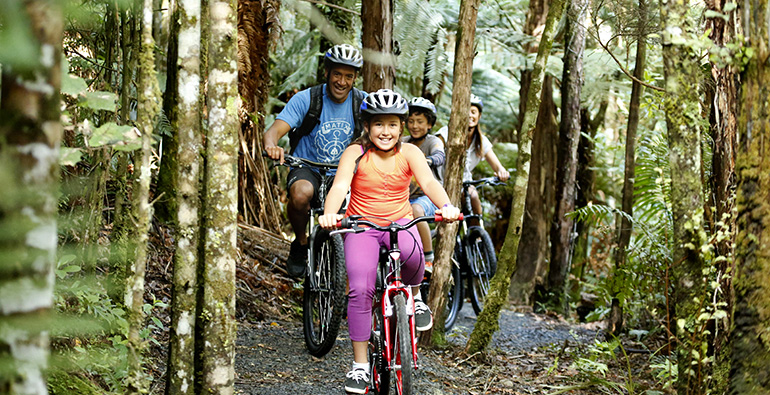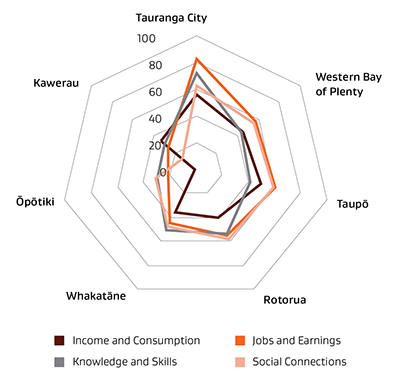Resilience
On this page

© Love Taupo
Businesses, communities, and households across the Bay of Plenty are supported to be resilient in the face of sustained disruption, with our people supported and prepared to react and adapt as needed.
The Bay will continue to face an array of disruptions. Building true resilience into our workforce will require a multi-faceted approach and different support for individuals, whānau and communities. Part of an effective response will include finding ways to equip our people with skills earned through the education system but also skills that enable individual agility such as entrepreneurialism and financial literacy. It will also require embedding a culture of relationship and alliance into our communities and sectors, through activity such as working with employers to help plan ahead for and remain beside their workers through disruptive times.
Workforce Resilience Indicators

This radar graph compares all of the Bay of Plenty sub-regions including Taupō District, Tauranga, Western Bay of Plenty, Rotorua, Whakatāne District, Kawera and Ōpōtiki District across key workforce resilience indicators. The graph shows how resilient different part of the Bay’s workforce is across the region as a whole. It shows that Tauranga City has the highest overall workforce resilience followed by Taupō District, Rotorua and Western Bay of Plenty while the Eastern Bay of Plenty districts including Whakatāne District, Kawera and Ōpōtiki District appear to be less resilient overall then the other sub-regions. Graph is sourced from Infometrics, 2021.
Our approach
The Group selected this aspiration because they recognised that there are many ways (apart from climate change disruption) that the regional workforce can be disrupted, including pandemics, supply chain disruption and recession (e.g impact of COVID-19 on the Tourism sector in Rotorua[46]). Future proofing the workforce from disruption is important for the continued prosperity of the region. For the sake of clarity, the Group has adopted the following definition from a research paper that was undertaken within the region:
“Resilience is a dynamic process of adaptation to adversity which enhances wellbeing. A sense of optimism arises when, instead of being at the mercy of unmanageable external forces, people can use their adaptive capacity to absorb change and take control over their future direction[47]“
The Bay of Plenty is known to have a high degree of industry diversity and therefore has traditionally appeared to have held up well when economic shocks have impacted New Zealand (Infometrics Ltd, 2022. Herfindahl–Hirschman Index – HHI). However, this effect masks the fact that there are pockets of deprivation across the region with workers who are more vulnerable to economic shocks.[48]
To tighten its approach, the Group spoke to regional stakeholders and analysed workforce indicators to identify the profile of those who needed help with resilience. This led to a focus on income, employment, skills, social wellbeing and connectivity indicators as there is evidence that workers with low levels of these indicators are more susceptible to labour market shocks and disruptions.[49] The Group looked across the regions and sectors to ascertain where there are higher volumes of workers fitting this profile and investigated demographic factors.
Key insights
They found that while there are some sub-regions (Eastern BOP and Rotorua) that have higher overall deprivation, adopting a narrow focus would mean that some workers who need help would miss out.[50] Therefore, it is important that any actions are region-wide. The BOP is a region with a higher than national average Māori unemployment rate and Māori are over-represented in sections of the workforce that are susceptible to crises such as COVID-19.[51] The Group focussed on sectors with higher numbers of Māori in low skilled occupations. This led to the focus on Horticulture, Forestry, Aquaculture, Tourism, Manufacturing and Construction.[52]
Stakeholders told the Group that strong partnerships and alliances are key to a resilient workforce. This means having strong bonds between workers, community, employers, and decision-makers in the region[53] and that the solutions needed are already present within the community.
The Group reflected on work undertaken by the iRSLG to understand the workforce pipeline (under the BOP iRSLG data pipeline project [54]) and the need for a unified and ‘all of system’ approach to support workers along that pipeline. This chapter and its related actions demonstrate another step forward in that thinking but is still not a complete picture. The Group acknowledges that in its next plan the next iteration of the RWP, a framework (developed with regional stakeholders) will need to be developed.
Stakeholders also pointed out the use of deficit thinking for Māori. Resilience is a social construct and Māori have been resilient since 1840. While there is evidence that Māori are economically vulnerable to shocks[55], this is not the wider story. There is unmistakable evidence that Māori have their own approach to resilience.[56] Good models of supporting worker resilience mitigate against inequities by addressing driver licensing, digital access, and employability skills for marginalised groups. Entrepreneurial skills and financial literacy can then be built over the basics to facilitate transformational resilience.
The question is whether support is ubiquitous and readily available to everyone. There is an opportunity to scan across the region to check uniform provision for the following:
- Driver licensing
- Financial literacy and entrepreneurial skills
- Employability and career confidence building
- Digital access
Stakeholders told the Group that low and semi-skilled roles for many of the focus sectors are in steep decline (e.g. Manufacturing). Jobs with seasonal component expose workers to some vulnerability due to their inherent seasonality. Tourism jobs were impacted because of COVID-19 demonstrating a susceptibility to shocks – there are many Māori employers in tourism across the region.[57]
Case study: Galvanising people to be a skilled workforce
The Manawa Tū Work for Life Centre (WFLC) employment service provides support for local community members that are work-ready. These clients enquire and are looking for guidance and support from the centre such as CV updates and cover letter writing, driver license upgrades, career change advice and support with local employment opportunities including transport. They have recently noticed an increase in new clients who have lost their jobs due to COVID-19 mandates.
Manawa Tū WFLC, in partnership with New Zealand Welding, Trades & Services (NZWTS) Rotorua, refer clients to the Construction and Warehouse Yard Operations & Forklift 12-week programmes as they provide transport from Murupara to Rotorua and back. Clients register with the centre and are supported with driver’s license upgrades and employment on completion of their programme.
Other providers in Rotorua that clients have been referred to are the Animation College and Toi Ohomai.
Resilience action statements
- Enable workforce resilience across individual, community and industry layers by partnering with and coordinating between Iwi/hapū, industry groups, employers, and key government agencies (through the following sub-actions):
- Partner with iwi/hapū and Māori employers around their approaches to worker support and look for opportunities to improve Māori resilience.
- Co-ordinate between those who provide support to Māori workers in the community and the employers who recruit them to find ways to improve workforce resilience.
- Engage with development of the Income Insurance Scheme to identify other components that could wrap around the scheme to produce a more complete system of support.
Footnotes
[46] | Bay of Plenty Local Insights Report October 2021
[47] | Resilient Communities Murupara (Project Report)(external link) — University of Otago
[48] | New Zealand Index of Deprivation(external link) — Massey University
[49] | Resilient Communities Murupara (Project Report)(external link) — University of Otago
[50] | Bay of Plenty Regional Leadership Group Regional Labour Market and Socio Economic Profile
[51] | Māori Employment – Impact of COVID-19, July 2020(external link) — Te Puni Kokiri
[52] | Māori Employment – Impact of COVID-19, July 2020(external link) — Te Puni Kokiri
[53] | Community resilience: A rapid evidence review of ‘what matters’ and ‘what works’ [PDF, 1.3MB](external link) — Ministry of Social Development
[54] | Interim Regional Skills Leadership Group (iRSLG) BOP Data pipeline project closure report [PDF, 3.4 MB]
[55] | Te Mahere Whai Māori: Māori employment action plan [PDF, 4 MB]
[56] | Māori authorities show resilience despite COVID-19 impacts.(external link) — Statistics New Zealand

